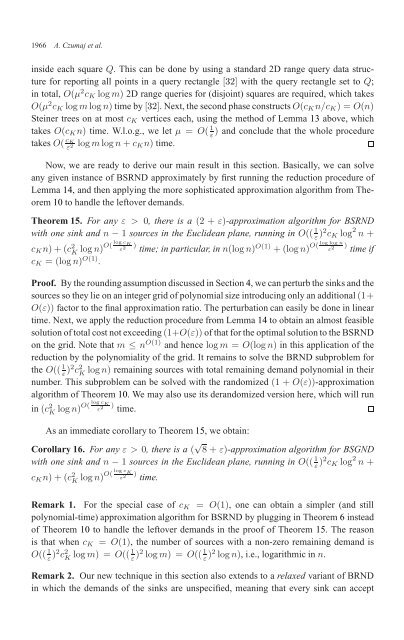Approximation Algorithms for Buy-at-Bulk Geometric Network Design
Approximation Algorithms for Buy-at-Bulk Geometric Network Design
Approximation Algorithms for Buy-at-Bulk Geometric Network Design
You also want an ePaper? Increase the reach of your titles
YUMPU automatically turns print PDFs into web optimized ePapers that Google loves.
1966 A. Czumaj et al.inside each square Q. This can be done by using a standard 2D range query d<strong>at</strong>a structure<strong>for</strong> reporting all points in a query rectangle [32] with the query rectangle set to Q;in total, O(µ 2 c K logm) 2D range queries <strong>for</strong> (disjoint) squares are required, which takesO(µ 2 c K logmlogn) time by[32]. Next, the second phase constructsO(c K n/c K ) = O(n)Steiner trees on <strong>at</strong> most c K vertices each, using the method of Lemma 13 above, whichtakes O(c K n) time. W.l.o.g., we let µ = O( 1 ε) and conclude th<strong>at</strong> the whole proceduretakesO( cKεlogmlogn+c 2 K n) time.Now, we are ready to derive our main result in this section. Basically, we can solveany given instance of BSRND approxim<strong>at</strong>ely by first running the reduction procedure ofLemma 14, and then applying the more sophistic<strong>at</strong>ed approxim<strong>at</strong>ion algorithm from Theorem10 to handle the leftover demands.Theorem 15. For any ε > 0, there is a (2 + ε)-approxim<strong>at</strong>ion algorithm <strong>for</strong> BSRNDwith one sink and n − 1 sources in the Euclidean plane, running in O(( 1 ε )2 c K log 2 n +c K n)+(c 2 c KK logn)O(log ε 2 ) time; in particular, inn(logn) O(1) +(logn)c K = (logn) O(1) .log nO(logε 2) time ifProof. By the rounding assumption discussed in Section 4, we can perturb the sinks and thesources so they lie on an integer grid of polynomial size introducing only an additional(1+O(ε)) factor to the final approxim<strong>at</strong>ion r<strong>at</strong>io. The perturb<strong>at</strong>ion can easily be done in lineartime. Next, we apply the reduction procedure from Lemma 14 to obtain an almost feasiblesolution of total cost not exceeding(1+O(ε)) of th<strong>at</strong> <strong>for</strong> the optimal solution to the BSRNDon the grid. Note th<strong>at</strong> m ≤ n O(1) and hence logm = O(logn) in this applic<strong>at</strong>ion of thereduction by the polynomiality of the grid. It remains to solve the BRND subproblem <strong>for</strong>the O(( 1 ε )2 c 2 K logn) remaining sources with total remaining demand polynomial in theirnumber. This subproblem can be solved with the randomized (1 + O(ε))-approxim<strong>at</strong>ionalgorithm of Theorem 10. We may also use its derandomized version here, which will runin(c 2 log c K logn)O( Kε 2 ) time.As an immedi<strong>at</strong>e corollary to Theorem 15, we obtain:Corollary 16. For any ε > 0, there is a ( √ 8 + ε)-approxim<strong>at</strong>ion algorithm <strong>for</strong> BSGNDwith one sink and n − 1 sources in the Euclidean plane, running in O(( 1 ε )2 c K log 2 n +c K n)+(c 2 c KK logn)O(log ε 2 ) time.Remark 1. For the special case of c K = O(1), one can obtain a simpler (and stillpolynomial-time) approxim<strong>at</strong>ion algorithm <strong>for</strong> BSRND by plugging in Theorem 6 insteadof Theorem 10 to handle the leftover demands in the proof of Theorem 15. The reasonis th<strong>at</strong> when c K = O(1), the number of sources with a non-zero remaining demand isO(( 1 ε )2 c 2 K logm) = O((1 ε )2 logm) = O(( 1 ε )2 logn), i.e., logarithmic inn.Remark 2. Our new technique in this section also extends to a relaxed variant of BRNDin which the demands of the sinks are unspecified, meaning th<strong>at</strong> every sink can accept
















